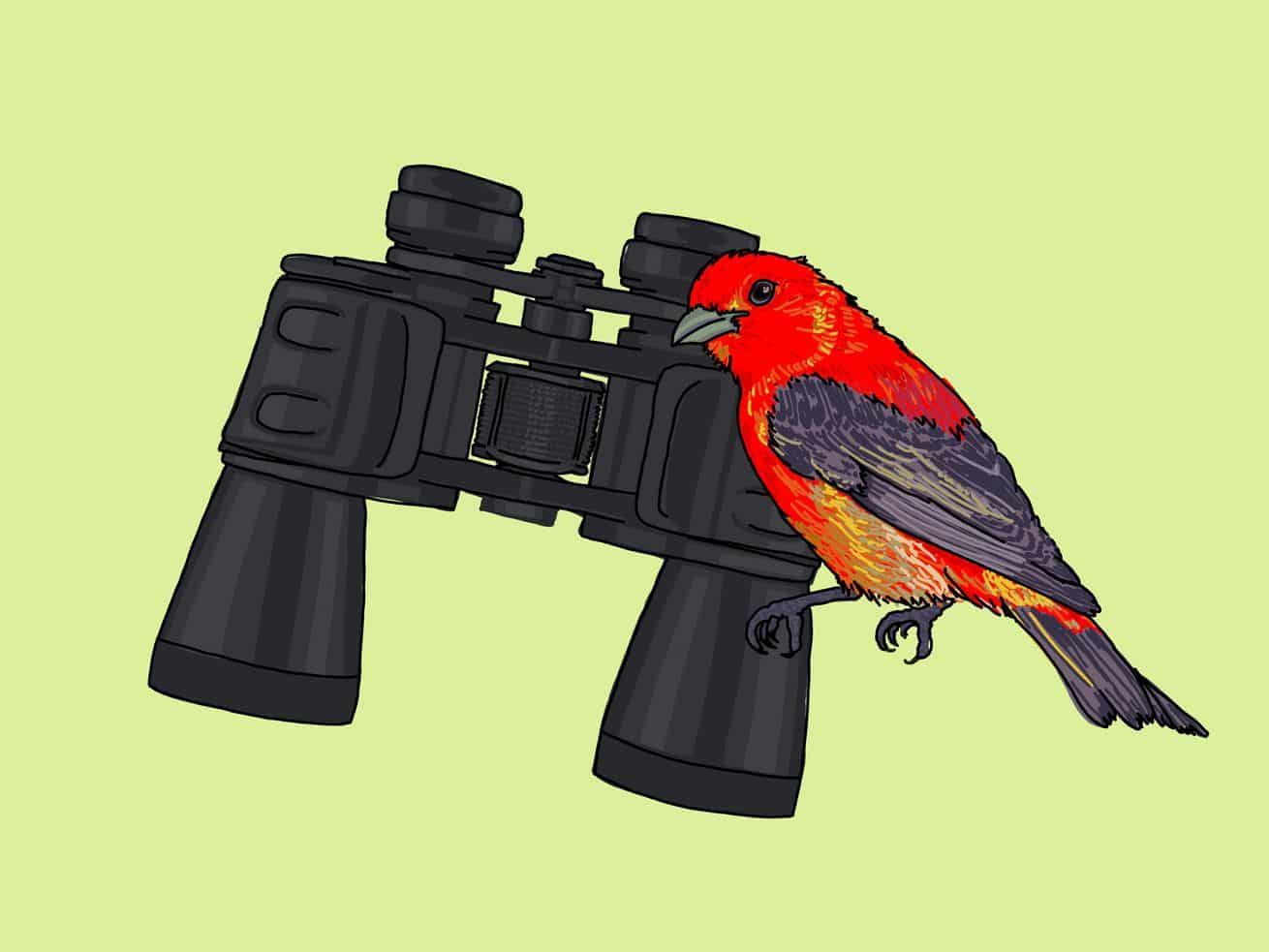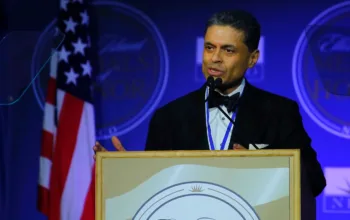The hobby is basically Pokémon Go, but for nature.
If you were to take a poll of which bird people most associate with New York City, it would surely be the pigeon. These ubiquitous “flying rats” (as my dad calls them) are incessantly cooing and pooping and head-bobbing at the edges of residents’ peripheral vision on street corners all over the city. I have spent the two decades I’ve lived here vaguely hoping they wouldn’t accidentally brush up against me.
But pigeons, which are actually quite beautiful if you stop and look at them, are far from the only avian residents. I’m embarrassed that I didn’t know until recently that there are more than 200 species that live here or pass through. I know it now, though, because I’ve become a bird person.
Birding experienced a surge in interest in the US during the pandemic, as millions of people stuck in their homes began to notice the wildlife right outside their windows. Bird feeder sales shot up. Walking around outside was one of the few activities that felt truly safe. And if you could do that, you could watch birds, because they’re everywhere.
In the middle of all the past year’s awfulness and uncertainty, my oldest son was applying to college. The city shut down the day before he was supposed to take his SAT exam. We had planned to go visit some colleges that spring but weren’t able to see any as the coronavirus surged. He didn’t want to write his admission essays after spending all day on Zoom isolated from his peers. We all fought about it a lot. Then at night, I’d lie awake worrying about him. The future had never looked more bleak or uncertain, and the thought of sending my child out into it was inconceivable to me.
Early in the pandemic, we spent time in upstate New York. Anxiety and an inability to focus made it difficult to read and write, the two activities I could normally count on to help keep me busy and avoid the minute-to-minute news monstrosities on Twitter. So I would sit on the porch and watch the birds. Soon, they stopped all looking like the same tiny brown blobs and I could pick out different kinds, even if I didn’t know their names. There were the curious gray ones that sounded like creepy babies. The ones that had geometric red and yellow and blue markings and pecked at the lawn. The ones with a red mark on their wings that scolded me whenever I walked by.
One day, I noticed a flash of red high up in the tree canopy, so I grabbed an old pair of binoculars from a drawer to try to get a better look at it. When it came into view, through the shaky, blurry, way-too-magnified lenses, it sat still for long enough so I could get a peek at its attributes and do a Google search. I felt a little thrill when I identified this exotic creature as a Scarlet Tanager. This became my “spark bird,” the first one that got me interested in really knowing more about birds. (I’m not original here — this brilliant red bird with black wings is a spark for a lot of people, according to a recent New York Times article about the uptick in newbie birders.) I wanted to see more.
I told my husband that for Christmas, I wanted decent binoculars. He spoke to my good friend Karen, who I met when our now college-bound sons were in kindergarten, to ask what kind of binoculars were the best. She and her family are deeply involved in the NYC birding community, and she had already gifted me a copy of The Sibley Field Guide to Birds of Eastern North America. (I once made fun of birders, before I was indoctrinated, when she told me some people call binoculars “bins.”)
On Christmas morning, I opened up my Nikon Monarch 5 binoculars, size 8×42 ($280) and my life hasn’t been the same since. Technically, I didn’t exactly buy these for myself, but I’ve been married to my husband for over 20 years and at this point, our finances are inextricably linked.
Unlike the crappy old pair I first used to study the tanager, these are magnified enough to see without straining the eyes or looking shaky, with a large enough field of vision to quickly pick out a flitty bird in a tree. Binocular prices can go beyond $2,000, so in the world of birding bins, these are fairly entry-level. I’ve used them almost every day since I got them.
Once I was able to see and identify birds more easily, I started a life list, a way of keeping track of all the birds you’ve identified. Karen describes birding as “like Pokémon Go, but for nature.” As a person who dragged two tween boys around the city hunting for rare Pokémon at the height of that craze, it’s a completely accurate analogy.
I uploaded the Audubon app and Cornell’s Merlin ID app, bought a couple more books, followed a bunch of accounts on Bird Twitter, and joined the American Birding Association’s “What’s this Bird?” Facebook group. Every time I went to Central Park, even in the winter, I was able to add something new to my list, which made me want to go back out and find even more birds. And yes, pigeons (Rock Pigeon, per Merlin) made the list.
I was one of the bundled-up people standing around the reservoir in Central Park to witness the other once-in-a-century phenomena that occurred this year, a rare NYC visit from a Snowy Owl. When I learned about all the sub-tropical species that come through New York City in the spring, I bought The Warbler Guide and threw myself into trying to learn how to differentiate them all. This spring, I’ve been out birding almost every single morning, either for a few minutes alone or on guided walks. Scarlet Tanagers have been abundant. And the best corrective to the tech neck I’ve acquired from a year of doomscrolling on my phone has been warbler neck, the act of hyperextending in order to spot flashes of yellow in the tops of the trees. Mostly, though, watching birds flit and hop is meditative and relaxing, two feelings I’ve been chasing since March 2020.
Since having kids, I really haven’t had many hobbies. The last one, blogging, became a job when I mounted a career change and switched from nursing to journalism. I haven’t really learned anything brand new that requires concentration and memorization in a long time. I recently had a big milestone birthday, and I’ve noticed that my memory for names and places is fuzzy. It’s scaring me, so it feels good to force my brain to work, to learn, to remember things again, like what a White-throated Sparrow sounds like and how to tell the differences among various woodpeckers. And I’m hoping it will keep me busy and distract me after I send my kid to college this fall. I’m going to look up the species that are abundant near his campus.
Recently, two weeks before my son’s high school graduation, I was wandering around in Central Park alone, trying out my warbler ID skills. I came upon a “birdy” tree, ringed by photographers and binocular-wielding people all staring intently into its branches. I noticed a woman and her husband stroll up, part of this flock. It was a friend with whom I had been pretty close while our kids were in preschool together, back when I had a whole different set of worries about my child. When our kids went to different schools for kindergarten, we drifted apart, victims of a situational friendship and busy family and work lives. But during our half-hour catch-up on the park path, it was like no time had passed. We talked about birds we’d seen that day, our kids’ plans for the future, and our anxiety about sending our fledglings out into the world. Then, we made a date to go birding.
Cheryl Wischhover is a former nurse practitioner and current journalist who writes about the beauty industry, wellness, and retail. There are 99 birds on her life list.
Author: Cheryl Wischhover
Read More



